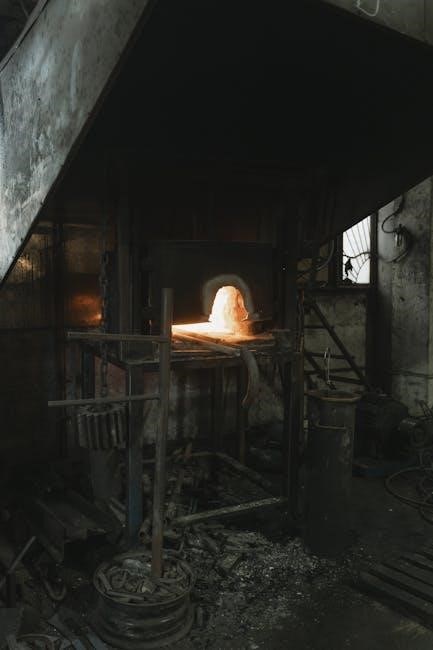
The Fire Angel Smoke Alarm Manual provides essential guidance for installing, maintaining, and troubleshooting smoke alarms․ It ensures compliance with fire safety regulations and helps users understand device operation for optimal protection․

What is a Fire Angel Smoke Alarm?

A Fire Angel Smoke Alarm is a cutting-edge fire safety device designed to detect smoke and heat, providing early warnings to prevent potential fires․ These alarms are available in various types, including optical, heat, and combination smoke and carbon monoxide models․ They are engineered for residential use, offering reliable detection of slow smouldering fires while minimizing false alarms․ Fire Angel Smoke Alarms are equipped with advanced features such as long battery life, smart silence functionality, and wireless interlink capabilities․ They are designed to comply with fire safety regulations and certifications, ensuring optimal protection for homes and families․ The alarms are user-friendly, with clear installation and maintenance instructions provided in their comprehensive manuals․ By integrating innovative technology, Fire Angel Smoke Alarms deliver accurate detection and timely alerts, safeguarding lives and property from fire hazards․
Importance of the User Manual
The user manual for the Fire Angel Smoke Alarm is an essential resource for ensuring proper installation, operation, and maintenance of the device․ It provides detailed instructions to help users understand the alarm’s features, functions, and requirements․ By following the manual, users can ensure their smoke alarm is installed in the correct locations, reducing the risk of false alarms and improving fire detection accuracy․ The manual also includes troubleshooting guides to address common issues, such as error codes or chirping sounds, helping users resolve problems quickly․ Additionally, it outlines maintenance routines, such as cleaning and testing, to maintain the alarm’s effectiveness over time․ Compliance with local fire safety regulations is simplified, as the manual explains how to meet necessary standards․ Ultimately, the Fire Angel Smoke Alarm manual empowers users to maximize the device’s performance, ensuring their home and family are protected from fire hazards․
Brief Overview of the Fire Angel Smoke Alarm System
The Fire Angel Smoke Alarm system is a comprehensive fire safety solution designed to provide early detection of fires and alert occupants to potential dangers․ The system includes a range of smoke alarms and accessories tailored to different environments, ensuring reliable protection for homes, businesses, and other properties․ At its core, the Fire Angel system is engineered to detect smoke or heat quickly, triggering loud alarms to give people time to evacuate safely․ It is compatible with various installation setups, including hardwired and battery-powered options, offering flexibility for different buildings․ The system also integrates advanced features such as smart connectivity, allowing users to monitor their alarms remotely and receive notifications in case of an emergency․ With a focus on durability, reliability, and ease of use, the Fire Angel Smoke Alarm system is a trusted choice for fire safety, providing peace of mind for users․

Types of Fire Angel Smoke Alarms

The Fire Angel range includes optical smoke alarms, heat alarms, combination smoke and carbon monoxide alarms, and smart connected smoke alarms, each designed for specific fire detection needs and environments․
Optical Smoke Alarms
Optical smoke alarms, part of the Fire Angel range, utilize advanced optical sensors to detect smoke particles in the air․ These alarms are highly effective at identifying slow-burning fires, which produce larger smoke particles․ Their optical technology reduces false alarms caused by cooking fumes or steam, making them ideal for kitchens and areas near bathrooms․ Designed with a sensitive infrared beam, these alarms detect even slight changes in light caused by smoke, ensuring early fire detection․ They are recommended for installation in bedrooms and living spaces where slow-burning fires are more common․ Fire Angel optical smoke alarms often feature a test button, hush function, and low-battery warning․ They meet stringent safety standards, such as BS 5446-2:2003, ensuring reliability and compliance․ Their tamper-proof design prevents unauthorized removal of batteries, enhancing safety․ With their high accuracy and user-friendly features, optical smoke alarms are a reliable choice for comprehensive fire protection in various home environments․
Heat Alarms
Heat alarms are an essential component of the Fire Angel smoke alarm system, designed to detect rapid temperature increases rather than smoke․ These alarms are particularly effective in areas where smoke alarms may not be suitable, such as kitchens, garages, or near bathrooms․ Heat alarms are less prone to false alarms caused by cooking fumes or steam, ensuring reliable performance․ They are activated when the temperature exceeds a predetermined threshold, typically around 58°C, making them ideal for detecting flaming fires․ Fire Angel heat alarms are designed to meet British Standard BS 5446:2003, ensuring they are reliable and effective in various environments․ They should be installed in conjunction with smoke alarms to provide comprehensive fire protection․ Unlike smoke alarms, heat alarms do not detect smoke particles, making them a complementary addition to a fire safety system․ Their robust design and precise temperature sensing ensure they remain a critical choice for safeguarding against fire hazards in specific areas of the home․
Combination Smoke and Carbon Monoxide Alarms
Combination smoke and carbon monoxide alarms are versatile devices designed to detect both smoke and carbon monoxide in a single unit․ These alarms are a comprehensive safety solution, offering dual protection for homes and businesses․ Fire Angel combination alarms are equipped with advanced sensors that can detect both smoke particles and carbon monoxide gases, providing early warnings for fire and gas leaks․ They are ideal for installation in areas where both risks are present, such as near boilers, fireplaces, or fuel-burning appliances; These alarms meet British Standards for both smoke detection (BS 5446:2003) and carbon monoxide detection (BS EN 50291:2010), ensuring reliability and effectiveness․ Many models feature a single test button for both sensors, simplifying maintenance․ They also often include adjustable sensitivity settings to minimize false alarms․ Combination alarms are a practical choice for homeowners seeking to streamline their fire and gas safety systems while maintaining high levels of protection․ They are particularly recommended for properties with multiple fuel-burning devices, ensuring a safer living environment year-round․
Smart Connected Smoke Alarms
Smart connected smoke alarms represent the latest innovation in fire safety technology, offering enhanced functionality and convenience․ These alarms integrate seamlessly with smart home systems, enabling users to monitor their smoke alarms remotely through a dedicated app․ Fire Angel smart alarms are equipped with Wi-Fi or Bluetooth connectivity, allowing real-time notifications to be sent to smartphones or tablets in the event of an alarm activation․ This feature is particularly beneficial for large properties or for individuals who want to stay informed about their home’s safety, even when away․
- Remote monitoring and notifications via app․
- Integration with smart home systems for centralized control․
- Customizable alerts for different devices or locations․
- VOICE ASSISTANT compatibility for hands-free operation․
- Battery status updates to prevent low-battery chirps․
Smart connected smoke alarms also allow users to silence false alarms remotely and receive maintenance reminders, ensuring optimal performance․ Their connectivity features make them a modern, user-friendly option for home safety․

Installation and Setup
Proper installation ensures safety and compliance․ Follow guidelines for alarm placement, wiring, and power sources․ Correct setup guarantees reliable performance and effective fire protection․
General Installation Guidelines
Ensure the smoke alarm is mounted on a solid surface, at least 30cm away from walls and 30cm below ceilings to avoid dead air spaces․ Choose a location central to the area it monitors․ For battery-powered alarms, select a reliable power source or hardwire according to the manual․ Avoid installing near kitchens, bathrooms, or drafty areas to minimize false alarms․ Keep the alarm away from extreme temperatures, humidity, or dust․ Use the provided mounting bracket and screws for secure placement․ After installation, test the alarm using the Test button to confirm proper function․ Refer to local fire safety regulations for specific requirements․ Always follow the manufacturer’s instructions for wiring and positioning to ensure optimal performance and compliance with safety standards․ Proper installation is critical for reliable detection and response in case of emergencies․ Regular testing and maintenance should also be scheduled as outlined in the manual․
Recommended Locations for Smoke Alarms
Smoke alarms should be installed in areas that provide early detection of fires, ensuring maximum safety for occupants․ Key locations include hallways outside sleeping areas, inside every bedroom, and on each level of the home․ Install alarms in living rooms, kitchens, and near heating sources, as these are common fire hazard zones․ Avoid placing alarms near bathrooms, windows, or drafty areas, as moisture and air currents can cause false alarms․ Ensure alarms are at least 30cm away from walls and corners to minimize dead air spaces․ For multi-story homes, install alarms on landings and staircases to cover all escape routes․ Additionally, consider areas with specific risks, such as near fireplaces or home offices with electrical equipment․ Always follow local fire safety guidelines for placement, as requirements may vary․ Proper placement ensures optimal detection and response, enhancing overall home safety․ Regular testing and maintenance are also crucial for reliable performance․
Step-by-Step Installation Process
Installing a Fire Angel smoke alarm requires careful planning and adherence to safety guidelines․ Begin by gathering necessary tools, such as a screwdriver, drill, and wall anchors․ Identify the recommended locations for installation, ensuring compliance with local fire safety regulations․ Turn off the power supply at the circuit breaker if wiring a hardwired model․ For battery-powered alarms, insert the batteries according to the manual’s instructions․ Mount the base plate on the wall or ceiling, using screws or adhesive strips provided․ Ensure the plate is level and secure․ Attach the smoke alarm to the base, twisting it clockwise until it clicks․ For wired systems, connect the wires to the terminal block, following the manufacturer’s wiring diagram․ Test the alarm by pressing the test button to ensure it sounds loudly․ Finally, clean the alarm to remove any dust or debris․ Refer to the manual for specific details, as installation steps may vary depending on the model․ Always follow safety precautions when working with electrical systems․
Wiring and Powering the Smoke Alarm
Proper wiring and powering are essential for the reliable operation of your Fire Angel smoke alarm․ For battery-powered models, insert the recommended battery type (typically 9V or 10-year lithium) into the compartment, ensuring it clicks securely․ Hardwired alarms require connection to your home’s electrical system․ Turn off the power supply at the circuit breaker before wiring․ Use the terminal block to connect the live, neutral, and earth wires, following the manual’s wiring diagram․ Ensure all connections are tight and secure․ For interlinked systems, connect the interlink wire between alarms to enable synchronized operation․ After wiring, restore power and test the alarm․ Always use a voltage tester to confirm power is off before working on hardwired systems․ Regularly check battery levels for non-hardwired alarms, replacing them as needed․ Never mix old and new batteries․ Proper wiring ensures continuous protection and avoids false alarms․ Always consult a licensed electrician if unsure about wiring procedures․

Maintenance and Troubleshooting
Regular maintenance ensures your Fire Angel smoke alarm operates effectively․ Clean the device monthly to remove dust, test it weekly, and replace batteries annually․ Address chirping by resetting or replacing batteries․ Troubleshoot issues promptly to maintain reliability and safety․
Cleaning and Dusting the Smoke Alarm
Cleaning and dusting your Fire Angel smoke alarm is essential to ensure its sensitivity and reliability․ Use a soft, dry cloth or a vacuum cleaner with a gentle brush attachment to remove dust from the exterior and vents․ Avoid using chemicals, water, or abrasive materials, as they may damage the sensor or other components․ For optical smoke alarms, gently vacuum the sensor chamber to prevent dust buildup, which can reduce accuracy․ Regular cleaning helps maintain the alarm’s performance and reduces the risk of false alarms․ It is recommended to clean the smoke alarm every 30 days, or more frequently in areas with high dust levels․ Always refer to the manual for specific cleaning instructions tailored to your Fire Angel model․ Proper maintenance ensures the device remains effective in detecting potential fires and protecting your home and family․
Testing the Smoke Alarm
Testing your Fire Angel smoke alarm is crucial to ensure it functions correctly and provides reliable fire detection․ Press and hold the test button on the front of the device until the alarm sounds․ This test checks the horn, circuitry, and battery (if applicable)․ Perform this test at least once a week to confirm the alarm is operational․ For interconnected systems, test one smoke alarm to ensure all units activate․ If the alarm does not sound during testing, check for low battery or wiring issues and replace batteries or consult the manual․ Additionally, test any auxiliary features, such as voice alerts or smart notifications, to ensure they are functioning․ Always refer to the manual for specific testing instructions for your model․ Regular testing ensures your Fire Angel smoke alarm remains responsive and ready to alert you in case of a fire․ This simple step is vital for maintaining your home’s fire safety system․
Understanding Error Codes and Chirps
Fire Angel smoke alarms use error codes and chirps to indicate specific issues, ensuring timely resolution․ Error codes, typically displayed as flashing lights or digital messages, signal problems like sensor malfunctions or connectivity issues in smart models․ Chirps, often a series of short beeps, usually indicate a low battery․ However, they can also signal other issues such as dust interference or system errors․
To address these, refer to the user manual for code meanings and solutions․ For chirps, replace the battery and clean the alarm․ Persistent issues may require professional assistance․ Prompt action ensures your smoke alarm remains reliable, crucial for fire safety․
Troubleshooting Common Issues
Troubleshooting common issues with Fire Angel smoke alarms ensures optimal performance and reliability․ One frequent problem is false alarms, often caused by cooking fumes or steam․ To resolve this, open windows for ventilation and clean the alarm; If the silence button isn’t working, check for button damage or low battery levels․ Replace batteries if necessary and test functionality;
Intermittent beeping may indicate a low battery or sensor obstruction․ Inspect for dust and clean the alarm thoroughly․ For smart models, connectivity issues can arise; restart the alarm and ensure stable Wi-Fi․ If problems persist, reset the device or consult the manual․ Addressing these issues promptly ensures your Fire Angel smoke alarm operates effectively, providing reliable fire detection and safety for your home․

Regulations and Compliance
Fire Angel smoke alarms must comply with local fire safety laws and standards to ensure reliability and effectiveness․ Regular inspections and maintenance are crucial for adherence to regulatory requirements and optimal performance․
Non-compliance can lead to safety risks and legal penalties, making it essential to follow all guidelines and updates provided by authorities and manufacturers to maintain a safe living environment․

Importance of Compliance with Fire Safety Regulations
Compliance with fire safety regulations is critical to ensuring the effectiveness and reliability of Fire Angel smoke alarms․ These devices are designed to meet or exceed industry standards, providing a reliable layer of protection against fire hazards․ By adhering to regulations, users can ensure their smoke alarms function optimally, reducing the risk of fire-related incidents․ Non-compliance may result in legal penalties, increased safety risks, and potential voidance of insurance coverage․ Fire safety regulations are established to safeguard lives and property, and proper installation, maintenance, and usage of smoke alarms are essential for compliance․ Regular inspections and updates to the system ensure ongoing adherence to evolving safety standards․ Compliance also ensures that smoke alarms perform as intended during emergencies, providing timely warnings to occupants․ Ultimately, adhering to fire safety regulations is a proactive step toward creating a safer living or working environment․
Always refer to local authority guidelines and manufacturer recommendations to maintain full compliance and ensure the system operates effectively․
Meeting Local Building Codes
Meeting local building codes is essential when installing Fire Angel smoke alarms to ensure compliance with regional fire safety requirements․ Building codes vary by location and are designed to address specific fire hazards common to the area․ Fire Angel smoke alarms are engineered to meet these diverse regulations, offering flexibility for different regions․ Understanding and adhering to local codes ensures that your smoke alarm system is appropriately installed, maintained, and functional, providing optimal protection․
Before installation, it is crucial to research the specific building codes in your area․ This includes requirements for the number of smoke alarms, their placement, and any additional features such as interconnectivity or battery type․ Fire Angel smoke alarms are designed to be adaptable, making it easier to meet local standards․ By adhering to these codes, you not only enhance safety but also avoid potential legal consequences․ Always consult local authorities or certified professionals to ensure full compliance with all applicable regulations․
Certifications and Standards
Fire Angel smoke alarms are designed to meet rigorous certifications and standards, ensuring reliability and effectiveness in fire detection․ These certifications are granted by recognized third-party organizations and are essential for verifying that the alarms comply with international safety regulations․ Fire Angel devices are tested to standards such as EN 14604 for smoke alarms and EN 50292 for carbon monoxide alarms, guaranteeing their performance under various conditions․
Certifications like BSI Kitemark and CE marking demonstrate that Fire Angel smoke alarms meet strict quality and safety criteria․ These standards ensure that the alarms can detect fires accurately, operate reliably, and provide consistent performance over their lifespan․ By adhering to these certifications, Fire Angel smoke alarms offer users peace of mind, knowing their safety is protected by products that meet or exceed industry benchmarks․

Features and Benefits
Fire Angel smoke alarms offer advanced detection, smart connectivity, and reliable performance․ Their sleek designs and user-friendly interfaces provide peace of mind, ensuring early fire detection and enhanced home safety․
Key Features of Fire Angel Smoke Alarms
The Fire Angel smoke alarms are equipped with cutting-edge technology to ensure maximum protection․ They feature advanced optical and heat sensors for accurate fire detection, minimizing false alarms․ Some models include smart connectivity, allowing users to receive alerts on their smartphones and interconnect multiple alarms for whole-home coverage․ The alarms are designed with a sleek, compact design and easy-to-use interfaces․ They also include a test/silence button for quick checks and muting nuisance alarms․ Select models offer additional features like escape lights, which provide visibility during emergencies, and voice alerts for clear notifications․ Fire Angel alarms are energy-efficient, with options for battery-powered or hardwired installations․ They also meet rigorous safety standards, ensuring reliability and compliance with fire safety regulations․ These features make Fire Angel smoke alarms a reliable choice for safeguarding homes and families against fire hazards․
Benefits of Fire Angel Smoke Alarms
Fire Angel smoke alarms offer numerous benefits that enhance fire safety and user convenience․ Their advanced detection capabilities provide early warnings, giving occupants precious time to react․ The alarms are reliable and designed to minimize false alerts, reducing unnecessary disturbances․ With models featuring smart connectivity, users can monitor their home’s safety remotely, adding an extra layer of reassurance․ Fire Angel alarms are also easy to install and maintain, making them a practical choice for homeowners․ Their energy-efficient design ensures long battery life, reducing the need for frequent replacements․ Additionally, Fire Angel smoke alarms are designed to meet stringent safety standards, ensuring compliance and peace of mind․ The combination of cutting-edge technology, durability, and user-friendly features makes Fire Angel smoke alarms an excellent investment for protecting lives and property․ Their reputation for quality and performance further solidifies their position as a trusted choice in fire safety․
Comparison with Other Smoke Alarm Brands
Fire Angel smoke alarms stand out among competitors due to their innovative features, reliability, and affordability․ Unlike many other brands, Fire Angel offers a wide range of models tailored to specific needs, from basic optical alarms to advanced smart-connected devices․ Their commitment to meeting stringent safety standards ensures superior performance compared to some budget-friendly alternatives; While other brands may focus solely on detection, Fire Angel integrates user-friendly designs, such as hush buttons and remote testing, enhancing convenience without compromising safety․ Additionally, Fire Angel alarms often include unique features like voice alerts and interconnected systems, which are not always standard in other brands․ Their focus on energy efficiency and long battery life also sets them apart, making them a cost-effective choice over time․ Overall, Fire Angel smoke alarms provide a balance of advanced technology, ease of use, and affordability, positioning them as a top contender in the market․